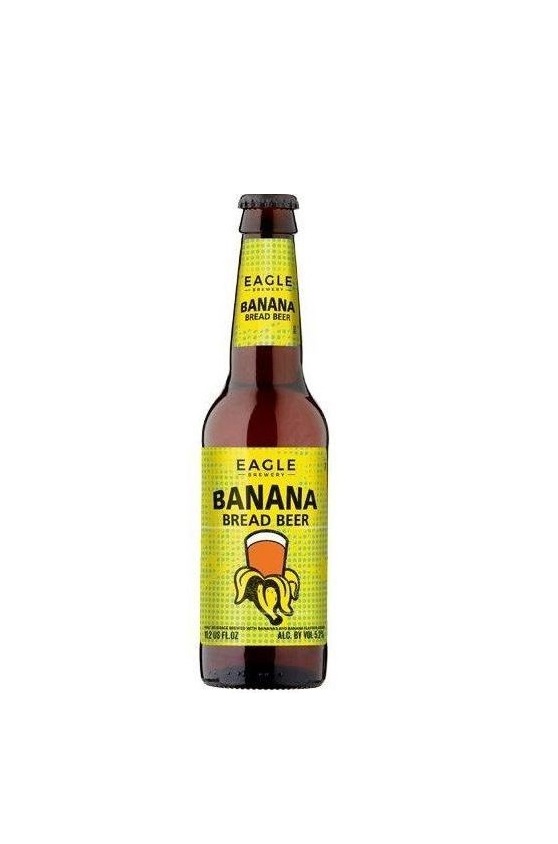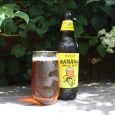Banana beer is a unique and traditional alcoholic beverage that has captivated the taste buds of many across various regions in Africa. This intriguing drink is primarily made from bananas, specifically the East African Highland bananas, which are known for their robust flavor and suitability for fermentation. Unlike typical beers that are brewed from barley and hops, banana beer incorporates a mash of bananas as its foundational ingredient. The process begins with the mashing of ripe bananas, which are then combined with water to form the primary substrate for fermentation.
To initiate and aid the fermentation process, additives such as sorghum, millet, or maize flour are included. These grains serve a critical role, not just as fillers, but as sources of wild yeast that naturally occur on their surfaces. These yeasts are essential for converting the sugars in the banana mash into alcohol. In regions where banana beer is produced, the choice of additive often depends on local availability and the desired flavor profile of the final product. Sorghum is particularly favored for its ability to enhance the beer’s body and flavor.
Banana beer is not just a beverage; it’s a cultural symbol in many African societies. It is often consumed during important community rituals and ceremonies, underscoring its significance beyond mere nutritional or recreational value. The production techniques and ingredients might vary slightly from one region to another, reflecting the diverse cultural landscapes of the continent. This beverage encapsulates the traditional brewing wisdom of various African communities, offering the world a taste of their rich cultural heritage through a glass of this distinctive and flavorful beer.
| Aspect | Details |
|---|---|
| Primary Ingredient | East African Highland bananas, known for robust flavor and fermentation suitability. |
| Brewing Base | Mash of ripe bananas combined with water. |
| Fermentation Additives | Sorghum, millet, or maize flour; provide wild yeast and enhance flavor or body. |
| Cultural Significance | Consumed during important rituals and ceremonies, symbolizing cultural importance in many African societies. |
| Regional Variations | Production techniques and ingredients vary, reflecting diverse cultural landscapes. |
Contents
Etymology
Banana beer, an indigenous beverage deeply rooted in the traditions of several African countries, is known by various names that reflect its cultural significance and regional dialects. In Uganda, it is referred to as “Mubisi,” a term that connects the drink to its primary ingredient—bananas, underscoring the simplicity and directness of local languages in naming their traditional products. Crossing into the Democratic Republic of Congo, banana beer adopts the name “Kasiksi,” illustrating the linguistic diversity and cultural nuances that characterize different African regions.

In Kenya, this traditional brew is called “Urwaga,” while neighbors in Rwanda and Burundi know it as “Urwagwa.” These names not only help identify the beverage but also provide insights into the linguistic ties and shared cultural practices across these regions. Each name carries with it a history of the beverage’s integration into daily life and special occasions, reflecting the beverage’s role in society and its adaptability to various cultural contexts.
| Country | Local Name | Cultural Significance |
|---|---|---|
| Uganda | Mubisi | Name reflects the primary ingredient and the simplicity of local language in naming traditional products. |
| Democratic Republic of Congo | Kasiksi | Illustrates linguistic diversity and cultural nuances. |
| Kenya | Urwaga | Highlights the linguistic ties and shared cultural practices in the region. |
| Rwanda and Burundi | Urwagwa | Reflects the beverage’s integration into daily life and special occasions, showcasing adaptability to cultural contexts. |
Background
The cultural significance of banana beer extends beyond its role as a mere refreshment. In many African societies, it is a pivotal element in rituals and ceremonies, often consumed during important communal gatherings, rites of passage, weddings, and traditional festivals. This widespread use underscores the beer’s role in fostering community cohesion and continuity of heritage. The ritualistic consumption of banana beer is not only a means of enjoyment but also a ceremonial act that reinforces social bonds and communal identity.
In Uganda, a similar product known as “mwenge bigere” mirrors the cultural importance of banana beer. Unlike the standard banana beer, mwenge bigere is made exclusively from bananas and sorghum, emphasizing the importance of these local ingredients in traditional brewing practices. This drink, like its counterparts, plays a significant role in local traditions and is steeped in the cultural identity of its people.
The regional variations and naming differences such as “kasiksi,” “nokrars,” “rwabitoke,” “urwedensiya,” “urwarimu,” and “milinda kaki” highlight the rich tapestry of cultural diversity found within the African continent. Each name and variant of the beer not only represents geographical distinctions but also the unique cultural practices, languages, and agricultural practices that influence and shape their production. For instance, the different names might reflect the specific type of banana or the unique brewing technique used, which can vary significantly from one community to another.

These variations are not just linguistic or nominal; they represent the deep-seated cultural frameworks and the intrinsic value that these communities place on banana beer. It is a symbol of heritage, a connector of communities, and a celebration of indigenous agriculture and brewing techniques. Through these traditional beverages, African societies maintain a link to their ancestors, preserving ancient practices in modern times and continuing to imbue contemporary celebrations with historical significance. The story of banana beer is thus a vivid illustration of how traditional beverages can carry profound cultural meanings and maintain a vital place in the social fabric of communities.
| Country/Region | Local Name | Cultural Significance |
|---|---|---|
| General (Multiple regions) | Banana beer | Consumed during communal gatherings, weddings, rites of passage, and festivals to foster community cohesion and continuity of heritage. |
| Uganda | Mwenge bigere | Emphasizes the importance of bananas and sorghum in local brewing practices, integral to cultural identity and traditions. |
| Various African regions | Kasiksi, Nokrars, Rwabitoke, Urwedensiya, Urwarimu, Milinda Kaki | Reflects regional linguistic, agricultural, and brewing differences; each name signifies the unique cultural practices and heritage of the local community. |
Production Process
The production of banana beer is a meticulous process that begins with the careful selection and preparation of East African Highland bananas. These bananas are known for their robust flavor and suitability for fermentation, making them the ideal choice for this traditional beverage.
Preparation of Ingredients
The ripening of bananas is a critical first step in the production of banana beer. Traditionally, this is achieved by using banana leaves in a method tailored to the local climate. In dry seasons, a hole is dug and lined with dried banana leaves, which are set alight to generate heat. Fresh banana leaves are then placed on top, followed by the unripe bananas, which are covered again with more fresh leaves and pseudostems. This setup retains heat and ethylene gases, catalyzing the ripening process over four to six days. During rainy seasons, the bananas are ripened by placing them near a cooking fire on a hurdle, which provides a steady source of warmth and accelerates the ripening.
Brewing Process
The types of bananas used in brewing are crucial to the flavor and quality of the beer. Two primary varieties are employed: the harsher tasting igikashi and the milder igisahira. The mixture typically consists of one-third igikashi to two-thirds igisahira, balancing the beer’s final taste profile. Once ripened, the bananas are peeled—an indicator of sufficient ripeness is the ability to peel them by hand. The bananas are then kneaded until they form a soft pulp. This pulp is mixed with water and the juice is extracted through filtration. The clear banana juice obtained is then diluted further with water. Sorghum, which has been ground and lightly roasted, is added to this mixture. The brew is left to ferment for about 24 hours before undergoing another round of filtration to remove any solids, ensuring a smooth final product.
Packaging and Preservation
After fermentation, banana beer is filtered to achieve clarity and smoothness. It is then packaged in glass or plastic bottles, depending on the scale of production and the intended market. In commercial settings, banana beer may undergo pasteurization before packaging. This process involves heating the beer to a specific temperature to kill any remaining yeast and bacteria, halting fermentation and extending the shelf life of the product. This step is crucial for ensuring the beer’s stability and safety during distribution and storage.
| Production Stage | Description |
|---|---|
| Selection of Bananas | East African Highland bananas are chosen for their robust flavor and fermentation suitability. |
| Preparation of Ingredients | Bananas are ripened traditionally using banana leaves and heat or ethylene gases, depending on the season. |
| Brewing Process | Bananas are peeled, kneaded into pulp, mixed with water and sorghum, and left to ferment. The mixture undergoes multiple filtrations to ensure smoothness. |
| Packaging and Preservation | After final filtration, the beer is packaged in glass or plastic bottles. Commercial production may include pasteurization to extend shelf life. |
Varieties and Commercial Brands
Banana beer is not only a traditional homemade beverage but also comes in various commercial brands and regional variations that cater to different tastes and preferences.
One notable variant is mbege, a traditional banana beer found in Tanzania. Mbege is still brewed in a traditional manner, emphasizing the cultural heritage and brewing practices unique to the region. It typically features a slightly different blend of ingredients, providing a unique flavor profile that distinguishes it from other types of banana beer.
Among the commercial brands, Mongozo Banana Beer is perhaps the most internationally recognized. It offers a distinct taste influenced by its unique brewing process and ingredient mix, catering to a global palate. Another brand, Raha, is popular in its local markets, providing a taste of traditional banana beer with a modern twist. Agashya is another brand that stands out for its commitment to maintaining the authentic flavor of traditional banana beer while ensuring consistency and quality in its production.
Each of these brands and varieties showcases the versatility and adaptability of banana beer, bridging traditional brewing techniques with modern commercial demands. This diversity not only helps preserve a significant cultural tradition but also introduces it to a global audience, allowing more people to appreciate this unique and flavorful beverage.
| Variant/Brand | Description | Unique Features |
|---|---|---|
| Mbege (Tanzania) | Traditional homemade banana beer. | Still brewed traditionally, emphasizing cultural heritage with a unique flavor profile. |
| Mongozo Banana Beer (International) | Commercial brand known internationally. | Offers a distinct taste influenced by a unique brewing process, catering to a global palate. |
| Raha (Local markets) | Popular commercial brand in local markets. | Blends traditional banana beer flavors with a modern twist. |
| Agashya (Local and regional markets) | Brand noted for quality and consistency. | Commits to maintaining the authentic flavor of traditional banana beer. |
Comparison with Related Products
Banana beer and banana wine are both traditional beverages derived from bananas, yet they differ significantly in their production processes and consumption patterns. Banana beer, as discussed, is an alcoholic beverage produced through the fermentation of mashed bananas with the addition of grains like sorghum, which provide the necessary wild yeasts. This beer is typically robust, with a somewhat cloudy appearance and a variable alcohol content depending on the fermentation duration and conditions.

Banana wine, on the other hand, is made by fermenting banana juice without the pulp, often resulting in a clearer and sweeter beverage with a higher alcohol content compared to banana beer. The production of banana wine involves a more controlled fermentation process, often utilizing specific strains of yeast rather than the wild yeasts found on sorghum or other grains. This leads to a smoother product with a more predictable flavor profile, which can appeal to those who prefer wine over beer.
In terms of consumption, banana beer is often associated with community gatherings and rituals, serving not only as a refreshment but also as an integral part of the social and cultural fabric. It is generally consumed in a casual setting, directly from the brewing vessel or poured into shared containers. Banana wine, meanwhile, is sometimes seen as a more refined product, enjoyed in a similar fashion to grape wines and often served in individual glasses. It can be found at formal events and is also marketed as a gourmet product in some areas, particularly appealing to tourists and visitors looking for unique local experiences.
| Beverage | Production Process | Alcohol Content | Consumption Context |
|---|---|---|---|
| Banana Beer | Fermented from mashed bananas with grains like sorghum, utilizing wild yeasts. Results in a robust, cloudy beverage. | Variable, depending on fermentation duration and conditions. | Often consumed at community gatherings and rituals, served from brewing vessels or shared containers. |
| Banana Wine | Fermented from banana juice without pulp, using specific yeast strains for a controlled fermentation. Results in a clearer, sweeter beverage. | Generally higher than banana beer, with a smoother and more predictable flavor. | Viewed as more refined, served in individual glasses at formal events, and marketed as a gourmet product appealing to tourists. |
Banana beer holds a significant place both culturally and commercially within many African communities. As a beverage, it transcends the mere act of consumption, embedding itself deeply in the traditions and daily lives of the people. Culturally, banana beer is more than just an alcoholic drink; it is a symbol of hospitality and community. It plays a pivotal role in rituals and ceremonies, marking significant life events and seasonal celebrations. This cultural relevance ensures that the traditions surrounding banana beer are preserved and passed down through generations, maintaining its status as a staple of local heritage.
Commercially, banana beer has found its way into the markets not only in Africa but around the world. With the rise of global interest in artisanal and traditional products, banana beer has captured the curiosity of international consumers, eager to explore different tastes and brewing techniques. This has led to the establishment of numerous small-scale industries focused on the production of banana beer, providing economic benefits to local communities by creating jobs and encouraging sustainable agricultural practices.
Furthermore, the uniqueness of banana beer as a traditional beverage is unmistakable. Its production from locally sourced bananas and natural ingredients speaks volumes about the ingenuity and resourcefulness of African brewers. It stands as a testament to the rich biodiversity of the region and the cultural importance of bananas in African societies. The beverage’s ability to adapt to modern tastes while maintaining its traditional roots is a key factor in its enduring popularity.
In conclusion, banana beer is not only a drink but a celebration of African heritage and communal spirit. Its production and consumption continue to foster social bonds and cultural identity among African communities. As it gains wider recognition on the global stage, banana beer not only enriches the tapestry of world beverages but also brings to light the profound cultural narratives of the people who create it.





